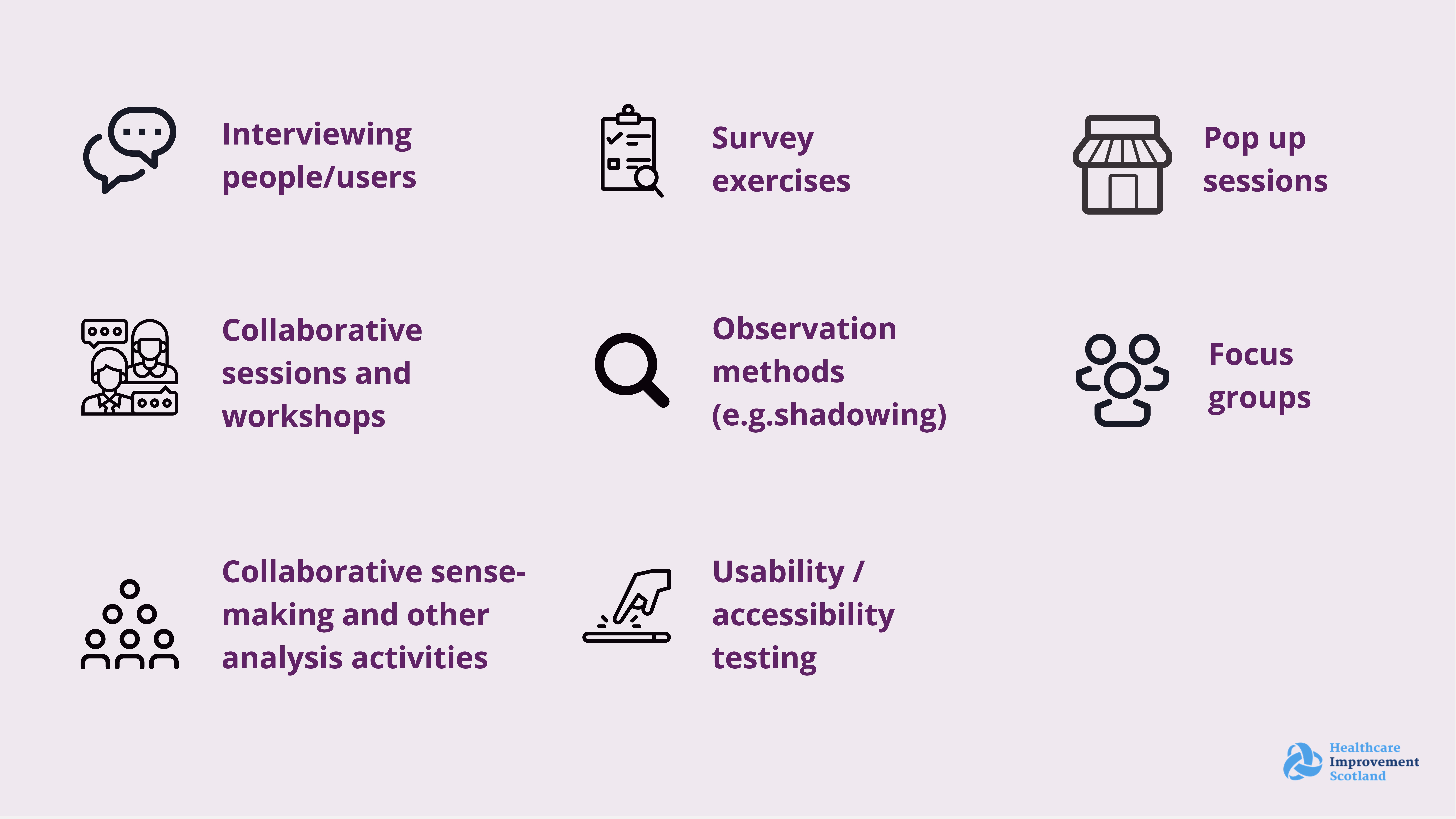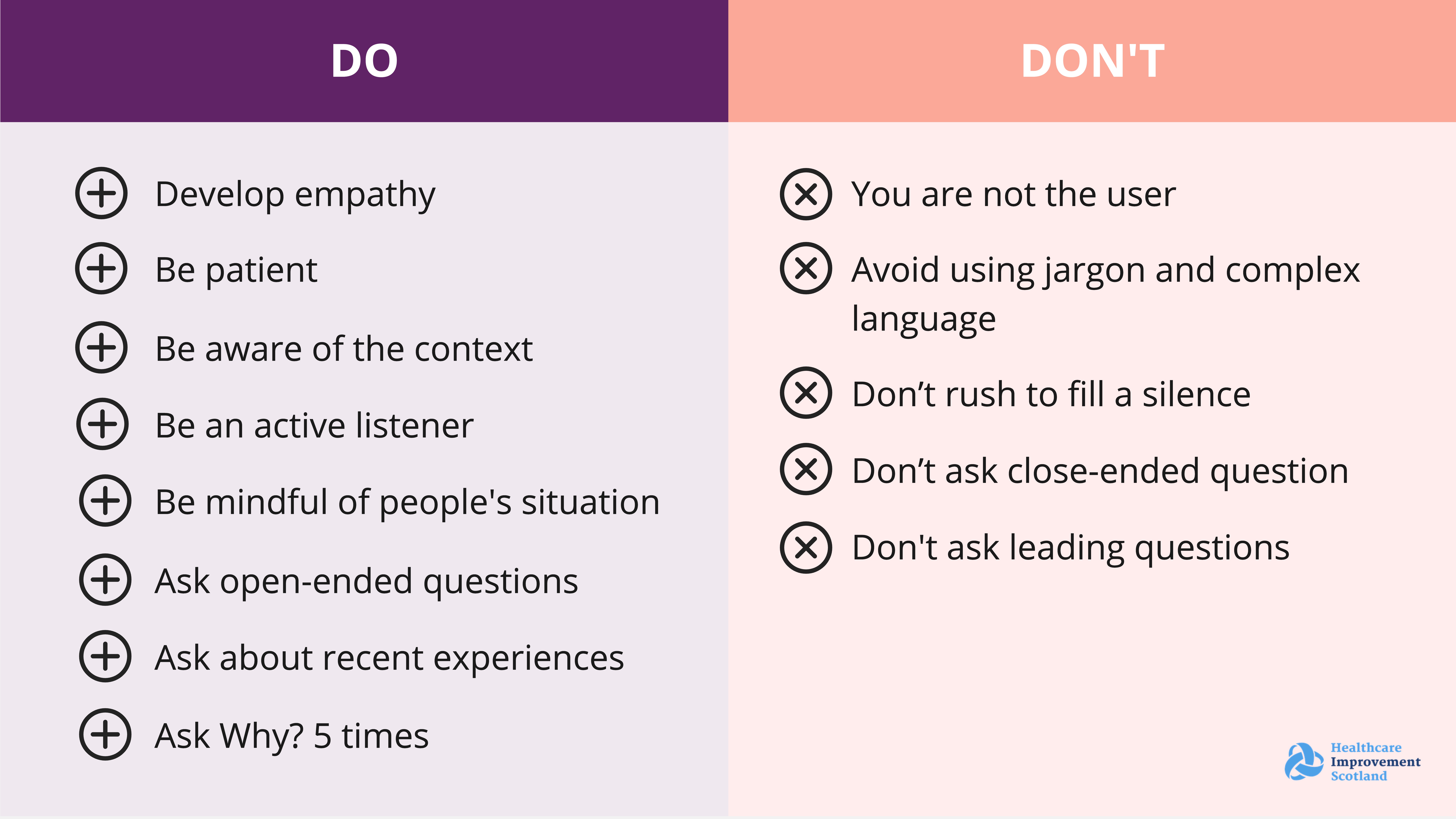Interviewing
User research focuses on understanding the people we're designing for.
Through interviewing and observing people, it helps teams understand their needs, how they behave and why.
There are multiple steps involved in effectively planning and conducting user research:
- Plan the research
- Recruit users
- Conduct research activities
- Gather and analyse research notes and findings
- Make sense of research findings
- Develop research insights if you’re confident in what you’ve heard during research
Why is user research important?
User research is extremely important to ensure organisations and internal teams understand the problem they’re trying to solve from the user's perspective and avoid spending time and resources solving the wrong problem.
Although typically conducting user research will incur a cost to the organisation, user research is less expensive than creating something your users don’t need and/or won’t use.
Importance of user research:
- Understand the problem you’re trying to solve.
- Avoid spending time and resources solving the wrong problem.
- Validate/refute internal assumptions, ensuring decisions are based on concrete data rather than assumptions or opinions.
- Understand desirability of a new/redesigned service or product.
- Design accessible and inclusive services/products considering the needs of diverse user groups with varying abilities, backgrounds, and preferences.
- Facilitates decision-making through concrete data and evidence to support strategic design decisions.
What are the different ways of conducting user research?
There are many ways to conduct user research, depending on your research objectives and your research constrains (e.g. budget).

What are user interviews?
User interviews are a qualitative research method in which the researchers engage in a one-to-one conversation with a user of service/product. The purpose of the interview is to have a conversation to gather insights, experiences, challenges and feedback directly from the people who interact or will interact with a service/product.
Structured, semi-structured and unstructured interviews
- Interviews can be structured (following a predefined set of questions), unstructured (allowing for open-ended conversation) or semi-structured (where research follow a conversation guide but allow flexibility in an open-ended conversation).
How to plan user interviews
Plan you research:
- Define objectives. Ask yourself “what do you want to learn?”
- Define User groups. Ask yourself “who is best to give us feedback about what we want to learn?”
- Define setting/formal of the interviews: phone, video, face-to-face
- Recruit users
- Write a conversation guide
- Need to have a Beginning, middle, end
- It's a reference point not a questionnaires
- Test it before you use it
- Prepare research stimuli/prompt if you want participants to engage with something visual during the interview.
How to recruit users for research
Recruiting participants for research activities can be difficult, so take that into account when planning your research activities. You can start by:
- Define your user criteria
List all the user groups you would like to interview based on a certain criteria. That criteria could include demographics, usage patterns, income-level, or other relevant characteristics.
- Define recruitment strategies
Once you have decided what user groups and criteria you want to recruit, you’ll need to think about different strategies to recruit them. There are different ways to go about recruiting participants:
- Use recruitment agencies
- Advertise your research activity though social media or printed advertisement
- If you want to recruit hard to reach participants, reach out to third sector organisations to help you recruit
You can make recruiting easier by ensuring that you make the time and location of your sessions as convenient as possible for your potential participants and offer some form of reward or incentive.
- Write how you will introduce this project
Write a concise and easy-to-read introduction to the research activity, so participants know what to expect: describe what the research session will look like, who is there, how long it will last, how much they will be compensated and how their data will be used.
- Think about incentives you might offer (cash, vouchers, warm fuzzies, ...)
Consider offering incentives to participants as appreciation for their time and insights. This could be in the form of gift cards, discounts, free access to your product, or other relevant rewards.
- Start recruiting and screen participants
Once you have potential participants, screen them to ensure they meet your defined criteria. This may involve a brief questionnaire or interview to assess their suitability.
- Ask for participant’s consent
Share a consent form with participants and ask them to read and sign it before the interview.
- Include information on what participants are being asked to agree to (participation, data storage etc). Include a reminder that participants can withdraw at anytime without giving a reason, and that participation or non-participation will not influence their current care or access to services.
How to conduct interviews
At the beginning:
- Have a cup of tea
- Introduce yourself and your team
- Ask for consent (signed form)
- Explain what the interview is going to be about and that the participant can withdraw consent at any time
During interview:
- Build a relationship with the participant but remain neutral
- Use the conversation guide as a guide but not as a questionnaire:
- Ask open-ended questions
- Ask about recent experiences
- Ask about actions, not opinions
- Ask Why? 5 times
- Take verbatim notes and quotes
- Observe behaviours and note workarounds
End of interview:
- Thank participants for their time
- Ask participants if they have any questions
- Ask participants if they’d like to be involved in further research activities
- Explain next steps and how they will receive compensation (if agreed)
Interview Do's and Don'ts

